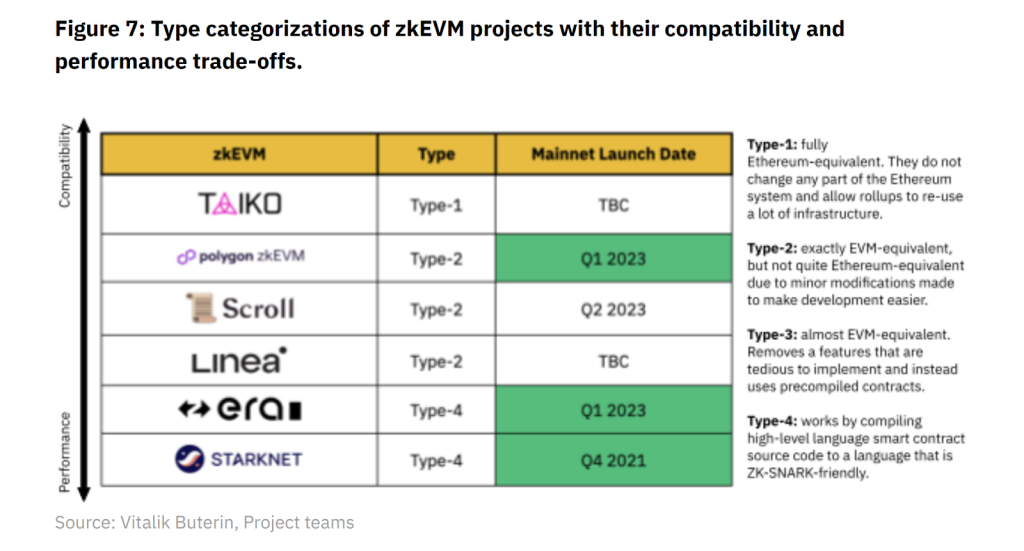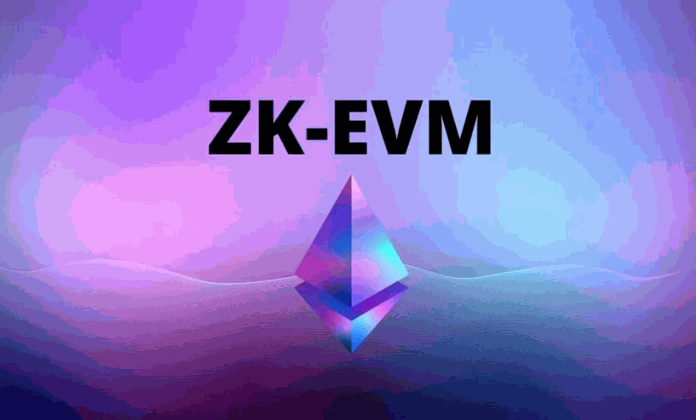In recent years, blockchain technology has seen numerous advancements and innovations, including ZkEVM or Zero-Knowledge Ethereum Virtual Machine. This technology has caught the attention of many projects and developers in the crypto space due to its potential to bring enhanced privacy and scalability to smart contracts. In this article, we’ll better understand ZkEVM and look at some notable projects leveraging this technology.
What is Zero-Knowledge Ethereum Virtual Machines (zkEVMs)
A zero-knowledge Ethereum Virtual Machine (zkEVM) is an innovative virtual machine designed to execute smart contract transactions on the Ethereum blockchain while utilizing zero-knowledge proofs. This ensures compatibility with zero-knowledge-proof computations and existing Ethereum infrastructure, improving transaction throughput and cost efficiency.
Components of zkEVMs
The two main components of a zkEVM are the Ethereum Virtual Machine (EVM) and zero-knowledge technology. Let’s explore these components further:
Ethereum Virtual Machine (EVM)
As the foundation of Ethereum’s vast ecosystem of decentralized apps (dApps), the EVM serves as the runtime environment for executing smart contracts on the Ethereum network. It can interpret smart contract code written in Solidity and other Ethereum programming languages, providing a universal platform for dApps. Zero-knowledge EVMs are EVM-compatible, meaning they can run smart contracts without significant changes to the underlying logic.
Zero-Knowledge Technology
Zero-knowledge proofs (ZKPs) enable one party to cryptographically prove to another that they possess knowledge about specific information without revealing the actual data itself. This technology plays a crucial role in zkEVMs as it provides a mechanism for proving the correctness of program execution and the validity of inputs and outputs.
How zkEVMs Work – Merging zero-knowledge proofs and EVMs
A zkEVM processes an initial state, computes transactions, and outputs an updated form accompanied by a zero-knowledge proof. It replicates the Ethereum environment as a zero-knowledge rollup, allowing developers to efficiently utilize existing Ethereum tools, port dApps, and smart contracts.
zkEVM Execution Environment
The EVM manages the execution of smart contracts and computes the state of the Ethereum network after each new block is added to the chain. It translates human-written Solidity code into computer-readable bytecode before updating the Ethereum state. The zkEVM extends this functionality by enabling smart contracts to run on a new type of EVM that processes transactions while generating zero-knowledge proofs.
zkEVM Proving Circuit
The proving circuit of a zkEVM generates zero-knowledge proofs that verify and validate transactions, ensuring that user transactions have been computed correctly and the new state is valid.
zkEVM Verifier Contract
In traditional Ethereum transactions, every node must verify each transaction. However, zero-knowledge rollups provide a more efficient layer-2 scaling solution by rolling up multiple transactions into a single batch, allowing for reduced processing time and user cost-sharing.
Benefits of zkEVMs
As the technology evolves, zkEVMs are expected to gain significant traction in the coming months. They will bring a range of advantages to the Ethereum ecosystem. Here are the most notable benefits:
Enhanced Scalability
By leveraging zk rollups, zkEVMs enable thousands of transactions per second (TPS), significantly improving Ethereum’s throughput and alleviating network congestion.
Lower Gas Fees
zkEVMs aggregate multiple transactions into a single proof, reducing the on-chain data storage requirements and lowering gas fees for users.
Data Privacy
zkEVMs utilize zero-knowledge proofs to maintain transaction confidentiality and user privacy without compromising the security and integrity of the blockchain.
EVM Compatibility/Equivalence
zkEVMs maintain compatibility with the Ethereum Virtual Machine, simplifying the migration of dApps and supporting seamless interoperability between L1 and L2 networks or different L2 solutions.
Types of zkEVMs
ZkEVMs have evolved to encompass different types that factor in trade-offs between ZKP performance efficiency and EVM compatibility. To better understand these trade-offs, Ethereum founder Vitalik Buterin has classified zkEVMs into four distinct types. This categorization allows a more precise comparison between various projects working towards creating zkEVMs with different levels of compatibility and performance.
As zk-rollup solutions gain traction, various projects have emerged with unique perspectives and applications in the field, including those utilizing zkEVM technology. Despite having a common goal of processing transactions and enhancing Ethereum’s scalability, each project can be distinguished based on its prioritization of compatibility and performance. By examining leading projects like zkSync and others in the market, we can better understand the diverse landscape of zkEVM projects and their respective categories.
Type categorizations of zkEVM projects with their compatibility and performance trade-offs

Let’s look closer at the development teams leading the way for zkEVMs. Here are the most prominent ones:
Polygon zkEVM
Polygon, a renowned developer of scalable Ethereum solutions, released its zkEVM mainnet on March 27, 2023. This project, praised by Ethereum co-founder Vitalik Buterin as a crucial component for future Ethereum scaling, Polygon’s zkEVM first surfaced in July 2022, boasting a higher transaction throughput than Optimistic rollups.
During its impressive testnet phase, Polygon zkEVM achieved several milestones, such as 84,000 unique wallet addresses participating, the generation of 75,000 ZK proofs, and over 5,000 smart contracts deployed. Today, Polygon has attracted more than 50 construction projects, spanning across dApps, DeFi projects, and partnerships, including Lens Protocol, Aavegotchi, 0vix, Quickswap, Etherscan, Phantom, Midnight Society, Luganodes, Celer, Gameswift, Yeeha Games.
zkSync Era
In a surprising announcement on March 24, 2023, zkSync unveiled the launch of zkSync Era, the first-ever zkEVM platform to become available on the Ethereum mainnet for users. This much-anticipated zkEVM is set to revolutionize transactions on the network, providing faster speeds and substantially lower costs compared to existing Ethereum-based solutions.
A key feature of zkSync Era’s zkEVM is Account Abstraction, which extends smart contract capabilities directly to users’ wallets. With Account Abstraction, users can benefit from account recovery services in case of forgotten private keys, merge transactions, multi-signature support, and numerous other improvements.
Scroll
Scroll is an innovative Layer 2 solution built upon zkEVM Equivalence technology, a ZK-Rollup method fully compatible with Ethereum Virtual Machine (EVM). This trailblazing project aims to improve the Ethereum ecosystem’s performance and scalability without sacrificing security or decentralization.
Following the successful completion of its Pre-Alpha testnet, Scroll launched its zkEVM on the Goerli testnet in early March and is expected to roll out the mainnet within the next 2 to 3 months. The Scroll team is actively working on enhancing the platform and addressing potential issues that may arise during the testnet phase.
So far, Scroll has managed to raise an impressive 83 million with a valuation of up to 1.8 billion. This funding has come from reputable investment funds that have backed the project, such as Polychain Capital, Sequoia Capital, Bain Capital Crypto, and Moore Capital Management. These consecutive fundraising rounds showcase investors’ faith in Scroll’s potential to disrupt the Ethereum scaling space.
Linea
Linea, developed by ConsenSys, the parent company of the well-known MetaMask wallets, is an ambitious zkEVM scaling solution for Ethereum, focusing on facilitating secure and efficient processing of transactions while staying true to the core principles of decentralization.
Linea introduced its public testnet on March 28, 2023, and has been working towards building a robust ecosystem that can cater to a wide range of applications. While still in its testnet phase, Linea has already garnered significant user traction, with many prominent projects participating in the ecosystem, such as Hop Protocol and LI.FI, Multichain, and Uniswap.
With ConsenSys’ expertise and infrastructure backing Linea, the platform is poised to build a robust ecosystem with essential components such as DeFi, NFT, and Gaming. This unique advantage Xsets Linea apart from its competitors and puts it in an excellent position to become an integral part of the Ethereum scaling landscape.
Conclusion
This article introduces zkEVM technology and some outstanding projects, such as Polygon zkEVM, zkSync Era, Scroll, and Linea. These projects continuously push the boundaries of Layer 2 solutions and serve as the backbone for Ethereum scaling development.
We hope the basic information about zkEVM and the featured projects will provide valuable insights into this evolving technology. Please remember that this article is for informational purposes only and should not be considered investment advice.


